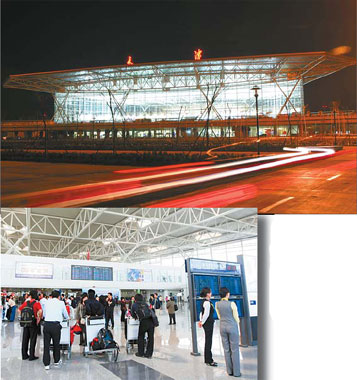|

|
|
Tianjin Airport's new terminal went into operation in April. |
Tianjin Airport's new terminal went into operation on April 28, bringing fresh development opportunities.
In July, passenger volume increased by 19.4 percent compared with the same period of last year, reaching a record monthly high of 413,000. At the same time, cargo and mail volume increased by 80.7 percent year-on-year, exceeding 18,000 tons.
Work on the new building began on August 8, 2005. Located on the east of the airstrips, the main building area is 116,000 sq m, with a height of 40.3 m, width of 165 m and it is 455 m from the main entrance to the end of the central hallway.
The exterior facades are made up of light green glass and the interior is bright and well lit.
The new terminal is a two-level structure with a mezzanine floor.
The fourth floor of the main building is an office and functional area.
The first floor of the main building is the arrival hall, the second the domestic and international departure hall with a check-in area, security, airport lounge, first-class lounge and other facilities.
It has 19 parking aprons, 60 ticket service counters and 17 security aisles.
The passenger boarding bridge has a scissor-shaped split-level design, which completely separates the arrival and departure flow.
There is also a transit counter on the mezzanine floor.
With the new building operational, Tianjin's airport is now divided by existing airstrips into the east part with the passenger terminal area, and the west part with the cargo terminal area.
The new terminal can handle annual passenger flow of 10 million people.
Tianjin was one of the first cities in China with a civil air transport system.
The Tianjin Binhai International Airport was built in November 1939. On August 1, 1950, the People's Republic of China's first flight route began.
The airport was also responsible for training professional pilots and technical aviation staff.
In October 1995, Tianjin Zhangguizhuang Airport was approved as an International Aerial Line Airport and in December of the same year, it became the Tianjin Binhai International Airport, approved by the then General Administration of the Civil Aviation of China.
It is estimated that by 2010, the airport will have more than 100 domestic and international air routes.
The domestic air routes will cover all capital cities, municipalities and major tourist cities.
A domestic flight network radiating around Tianjin will be established, and all small- and medium-sized airports less than 800 km from Tianjin will be open to air traffic.
There will be fast international flights to South Korea and Japan. In two years' time, flights to Singapore, Thailand, Malaysia and India will be launched, while routes to America and Europe are set to begin as soon as possible.
It is estimated that by 2020, the passenger volume of Tianjin Airport will be sixteen-fold of that in 2000.
(China Daily September 27, 2008)